2020 Hyundai Tucson seats
[x] Cancel search: seatsPage 57 of 637
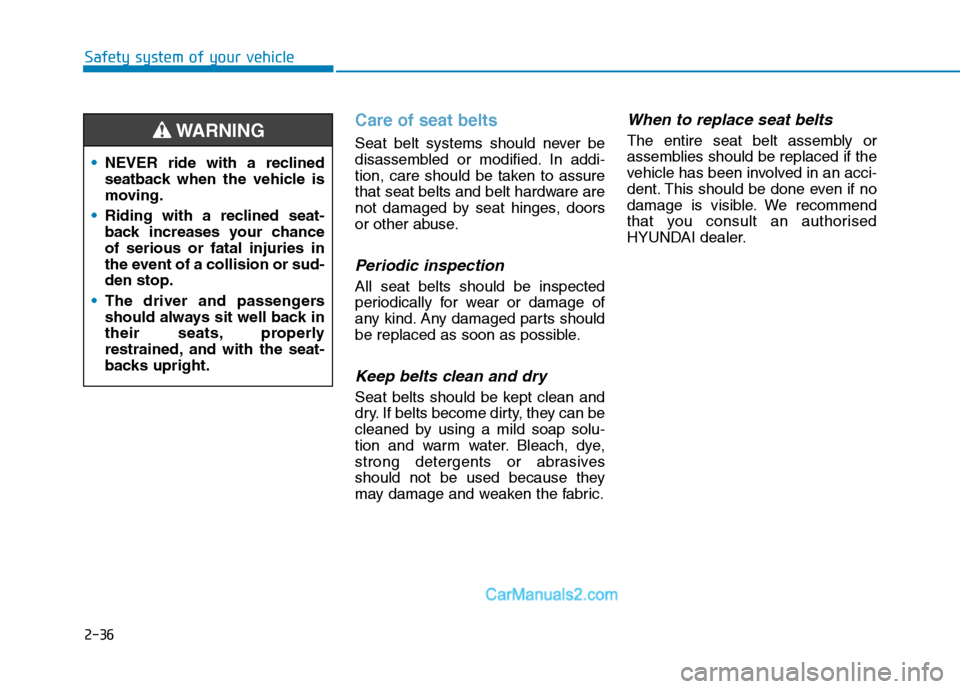
2-36
Safety system of your vehicle
Care of seat belts
Seat belt systems should never be
disassembled or modified. In addi-
tion, care should be taken to assure
that seat belts and belt hardware are
not damaged by seat hinges, doors
or other abuse.
Periodic inspection
All seat belts should be inspected
periodically for wear or damage of
any kind. Any damaged parts should
be replaced as soon as possible.
Keep belts clean and dry
Seat belts should be kept clean and
dry. If belts become dirty, they can be
cleaned by using a mild soap solu-
tion and warm water. Bleach, dye,
strong detergents or abrasives
should not be used because they
may damage and weaken the fabric.
When to replace seat belts
The entire seat belt assembly or
assemblies should be replaced if the
vehicle has been involved in an acci-
dent. This should be done even if no
damage is visible. We recommend
that you consult an authorised
HYUNDAI dealer. NEVER ride with a reclined
seatback when the vehicle is
moving.
Riding with a reclined seat-
back increases your chance
of serious or fatal injuries in
the event of a collision or sud-
den stop.
The driver and passengers
should always sit well back in
their seats, properly
restrained, and with the seat-
backs upright.WARNING
Page 58 of 637
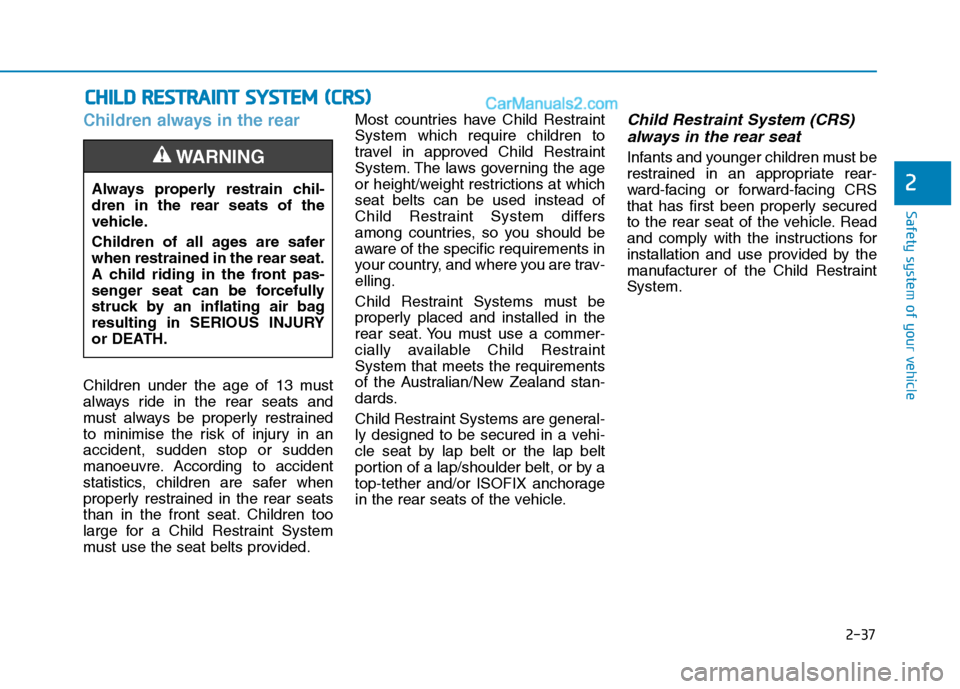
2-37
Safety system of your vehicle
2
Children always in the rear
Children under the age of 13 must
always ride in the rear seats and
must always be properly restrained
to minimise the risk of injury in an
accident, sudden stop or sudden
manoeuvre. According to accident
statistics, children are safer when
properly restrained in the rear seats
than in the front seat. Children too
large for a Child Restraint System
must use the seat belts provided.Most countries have Child Restraint
System which require children to
travel in approved Child Restraint
System. The laws governing the age
or height/weight restrictions at which
seat belts can be used instead of
Child Restraint System differs
among countries, so you should be
aware of the specific requirements in
your country, and where you are trav-
elling.
Child Restraint Systems must be
properly placed and installed in the
rear seat. You must use a commer-
cially available Child Restraint
System that meets the requirements
of the Australian/New Zealand stan-
dards.
Child Restraint Systems are general-
ly designed to be secured in a vehi-
cle seat by lap belt or the lap belt
portion of a lap/shoulder belt, or by a
top-tether and/or ISOFIX anchorage
in the rear seats of the vehicle.
Child Restraint System (CRS)
always in the rear seat
Infants and younger children must be
restrained in an appropriate rear-
ward-facing or forward-facing CRS
that has first been properly secured
to the rear seat of the vehicle. Read
and comply with the instructions for
installation and use provided by the
manufacturer of the Child Restraint
System.
C CH
HI
IL
LD
D
R
RE
ES
ST
TR
RA
AI
IN
NT
T
S
SY
YS
ST
TE
EM
M
(
(C
CR
RS
S)
)
Always properly restrain chil-
dren in the rear seats of the
vehicle.
Children of all ages are safer
when restrained in the rear seat.
A child riding in the front pas-
senger seat can be forcefully
struck by an inflating air bag
resulting in SERIOUS INJURY
or DEATH.
WARNING
Page 59 of 637

2-38
Safety system of your vehicle
Selecting a Child Restraint
System (CRS)
When selecting a CRS for your child,
always:
Make sure the CRS has a label
certifying that it that meets the
requirements of the
Australian/New Zealand standards.
Select a Child Restraint System
based on your child’s height and
weight. The required label or the
instructions for use typically pro-
vide this information.
Select a Child Restraint System
that fits the vehicle seating position
where it will be used.
Read and comply with the warn-
ings and instructions for installation
and use provided with the Child
Restraint System.
Child Restraint System (CRS)
types
There are three main types of Child
Restraint System: rearward-facing
seats, forward-facing seats, and
booster seats. They are classified
according to the child’s age, height
and weight.Always follow the Child
Restraint System manufactur-
er’s instructions for installa-
tion and use.
Always properly restrain your
child in the Child Restraint
System.
Do not use an infant carrier or
a child safety seat that
“hooks” over a seatback, it
may not provide adequate pro-
tection in an accident.
After an accident, we recom-
mend a HYUNDAI dealer check
the Child Restraint System,
seat belts, ISOFIX anchorages
and top-tether anchorages.
WARNING
Page 61 of 637
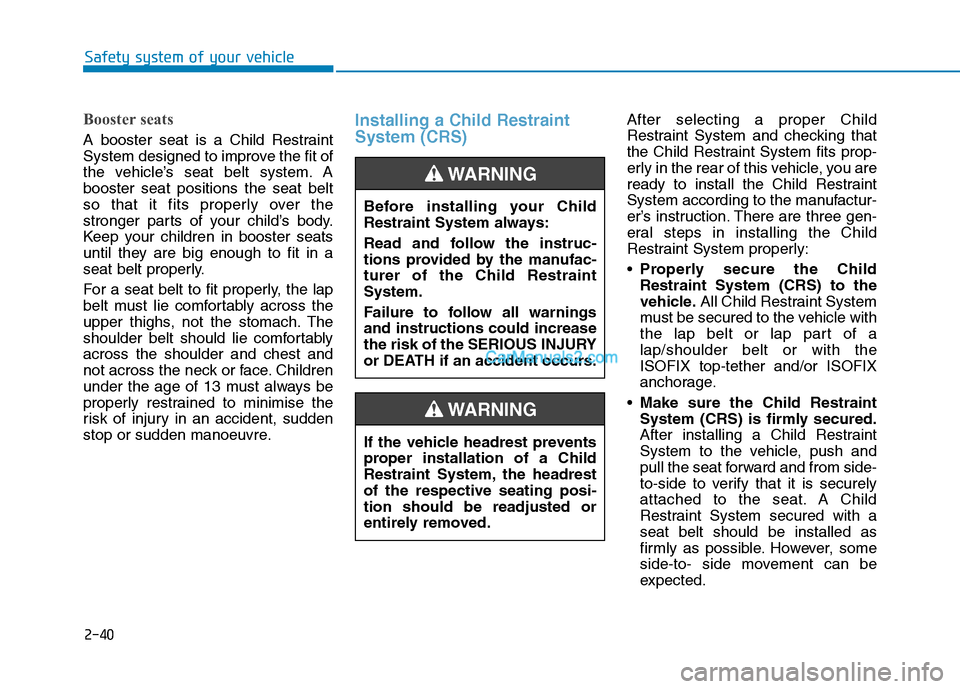
2-40
Safety system of your vehicle
Booster seats
A booster seat is a Child Restraint
System designed to improve the fit of
the vehicle’s seat belt system. A
booster seat positions the seat belt
so that it fits properly over the
stronger parts of your child’s body.
Keep your children in booster seats
until they are big enough to fit in a
seat belt properly.
For a seat belt to fit properly, the lap
belt must lie comfortably across the
upper thighs, not the stomach. The
shoulder belt should lie comfortably
across the shoulder and chest and
not across the neck or face. Children
under the age of 13 must always be
properly restrained to minimise the
risk of injury in an accident, sudden
stop or sudden manoeuvre.
Installing a Child Restraint
System (CRS)After selecting a proper Child
Restraint System and checking that
the Child Restraint System fits prop-
erly in the rear of this vehicle, you are
ready to install the Child Restraint
System according to the manufactur-
er’s instruction. There are three gen-
eral steps in installing the Child
Restraint System properly:
Properly secure the Child
Restraint System (CRS) to the
vehicle.All Child Restraint System
must be secured to the vehicle with
the lap belt or lap part of a
lap/shoulder belt or with the
ISOFIX top-tether and/or ISOFIX
anchorage.
Make sure the Child Restraint
System (CRS) is firmly secured.
After installing a Child Restraint
System to the vehicle, push and
pull the seat forward and from side-
to-side to verify that it is securely
attached to the seat. A Child
Restraint System secured with a
seat belt should be installed as
firmly as possible. However, some
side-to- side movement can be
expected. Before installing your Child
Restraint System always:
Read and follow the instruc-
tions provided by the manufac-
turer of the Child Restraint
System.
Failure to follow all warnings
and instructions could increase
the risk of the SERIOUS INJURY
or DEATH if an accident occurs.
WARNING
If the vehicle headrest prevents
proper installation of a Child
Restraint System, the headrest
of the respective seating posi-
tion should be readjusted or
entirely removed.
WARNING
Page 62 of 637
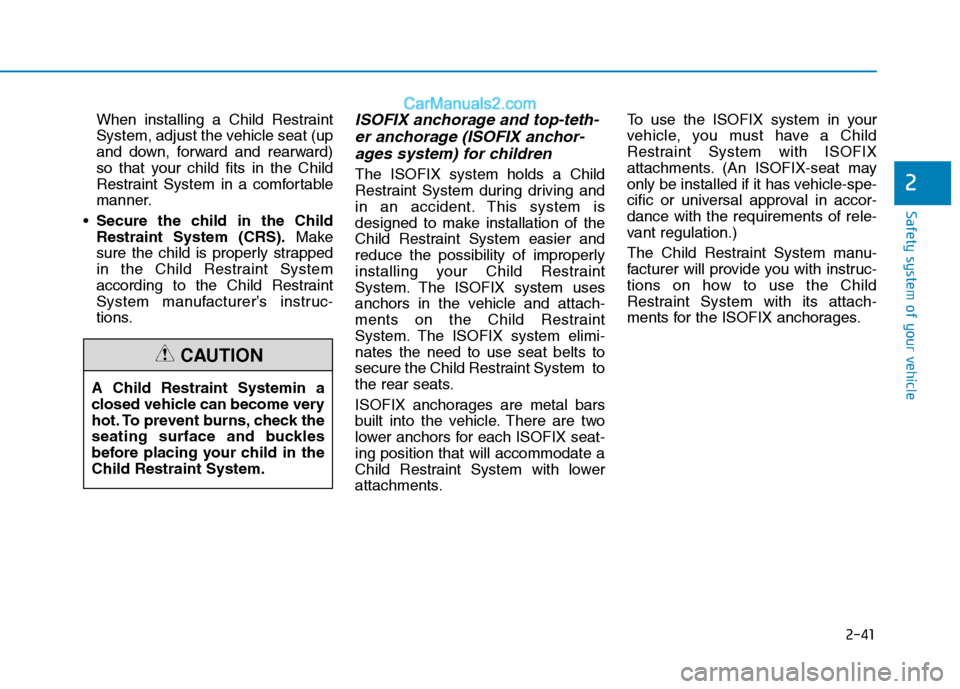
2-41
Safety system of your vehicle
2
When installing a Child Restraint
System, adjust the vehicle seat (up
and down, forward and rearward)
so that your child fits in the Child
Restraint System in a comfortable
manner.
Secure the child in the Child
Restraint System (CRS).Make
sure the child is properly strapped
in the Child Restraint System
according to the Child Restraint
System manufacturer’s instruc-
tions.ISOFIX anchorage and top-teth-
er anchorage (ISOFIX anchor-
ages system) for children
The ISOFIX system holds a Child
Restraint System during driving and
in an accident. This system is
designed to make installation of the
Child Restraint System easier and
reduce the possibility of improperly
installing your Child Restraint
System. The ISOFIX system uses
anchors in the vehicle and attach-
ments on the Child Restraint
System. The ISOFIX system elimi-
nates the need to use seat belts to
secure the Child Restraint System to
the rear seats.
ISOFIX anchorages are metal bars
built into the vehicle. There are two
lower anchors for each ISOFIX seat-
ing position that will accommodate a
Child Restraint System with lower
attachments.To use the ISOFIX system in your
vehicle, you must have a Child
Restraint System with ISOFIX
attachments. (An ISOFIX-seat may
only be installed if it has vehicle-spe-
cific or universal approval in accor-
dance with the requirements of rele-
vant regulation.)
The Child Restraint System manu-
facturer will provide you with instruc-
tions on how to use the Child
Restraint System with its attach-
ments for the ISOFIX anchorages.
A Child Restraint Systemin a
closed vehicle can become very
hot. To prevent burns, check the
seating surface and buckles
before placing your child in the
Child Restraint System.
CAUTION
Page 63 of 637
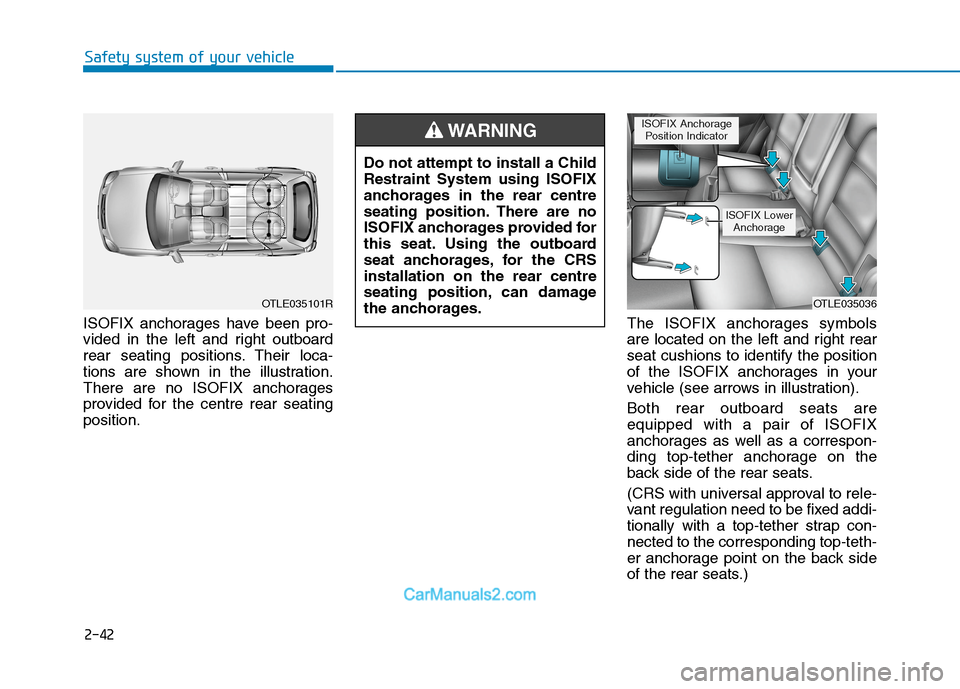
2-42
Safety system of your vehicle
ISOFIX anchorages have been pro-
vided in the left and right outboard
rear seating positions. Their loca-
tions are shown in the illustration.
There are no ISOFIX anchorages
provided for the centre rear seating
position.The ISOFIX anchorages symbols
are located on the left and right rear
seat cushions to identify the position
of the ISOFIX anchorages in your
vehicle (see arrows in illustration).
Both rear outboard seats are
equipped with a pair of ISOFIX
anchorages as well as a correspon-
ding top-tether anchorage on the
back side of the rear seats.
(CRS with universal approval to rele-
vant regulation need to be fixed addi-
tionally with a top-tether strap con-
nected to the corresponding top-teth-
er anchorage point on the back side
of the rear seats.) Do not attempt to install a Child
Restraint System using ISOFIX
anchorages in the rear centre
seating position. There are no
ISOFIX anchorages provided for
this seat. Using the outboard
seat anchorages, for the CRS
installation on the rear centre
seating position, can damage
the anchorages.
WARNING
OTLE035036
ISOFIX Anchorage
Position Indicator
ISOFIX Lower
Anchorage
OTLE035101R
Page 66 of 637
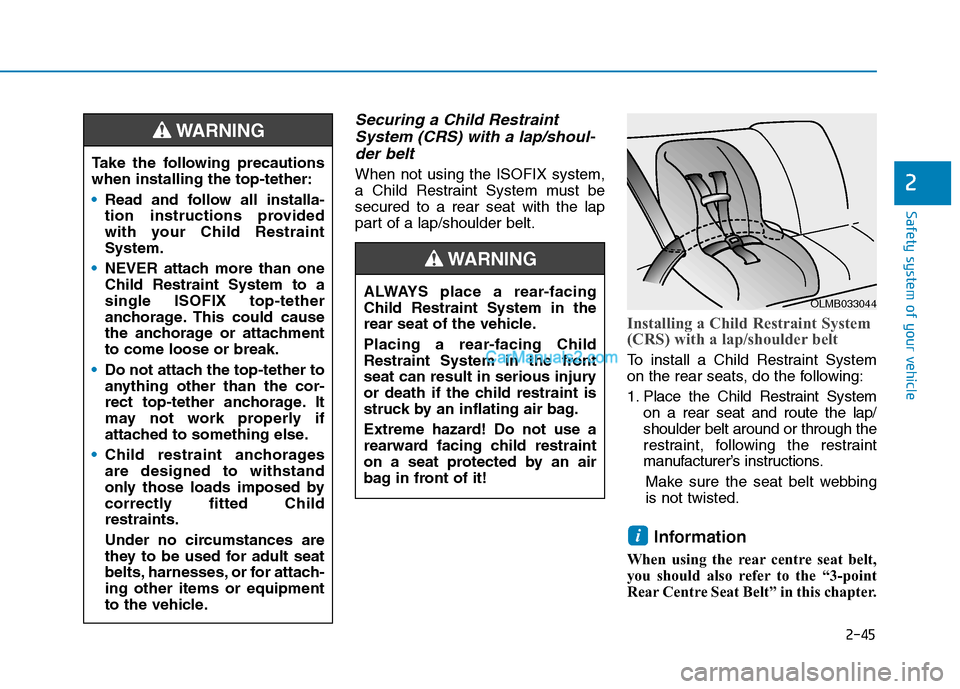
2-45
Safety system of your vehicle
2
Securing a Child Restraint
System (CRS) with a lap/shoul-
der belt
When not using the ISOFIX system,
a Child Restraint System must be
secured to a rear seat with the lap
part of a lap/shoulder belt.
Installing a Child Restraint System
(CRS) with a lap/shoulder belt
To install a Child Restraint System
on the rear seats, do the following:
1. Place the Child Restraint System
on a rear seat and route the lap/
shoulder belt around or through the
restraint, following the restraint
manufacturer’s instructions.
Make sure the seat belt webbing
is not twisted.
Information
When using the rear centre seat belt,
you should also refer to the “3-point
Rear Centre Seat Belt” in this chapter.
i
ALWAYS place a rear-facing
Child Restraint System in the
rear seat of the vehicle.
Placing a rear-facing Child
Restraint System in the front
seat can result in serious injury
or death if the child restraint is
struck by an inflating air bag.
Extreme hazard! Do not use a
rearward facing child restraint
on a seat protected by an air
bag in front of it!
WARNING
OLMB033044
Take the following precautions
when installing the top-tether:
Read and follow all installa-
tion instructions provided
with your Child Restraint
System.
NEVER attach more than one
Child Restraint System to a
single ISOFIX top-tether
anchorage. This could cause
the anchorage or attachment
to come loose or break.
Do not attach the top-tether to
anything other than the cor-
rect top-tether anchorage. It
may not work properly if
attached to something else.
Child restraint anchorages
are designed to withstand
only those loads imposed by
correctly fitted Child
restraints.
Under no circumstances are
they to be used for adult seat
belts, harnesses, or for attach-
ing other items or equipment
to the vehicle.
WARNING
Page 71 of 637

2-50
Safety system of your vehicle
Side air bags Your vehicle is equipped with a side
air bag in each front seat. The pur-
pose of the air bag is to provide the
vehicle’s driver and the front passen-
ger with additional protection than
that offered by the seat belt alone.
The side air bags are designed to
deploy only during certain side
impact collisions, depending on the
crash severity, angle, speed and
point of impact.
The side air bags are not designed to
deploy in all side impact situations.Do not allow passengers to
lean their heads or bodies
onto doors, put their arms on
the doors, stretch their arms
out of the window, or place
objects between the doors
and seats.
Hold the steering wheel at the
9 o’clock and 3 o’clock posi-
tions, to minimise the risk of
injuries to your hands and
arms.
Do not use any accessory
seat covers. This could reduce
or prevent the effectiveness
of the system.
Do not place any objects over
the air bag or between the air
bag and yourself. Also, do not
attach any objects around the
area the air bag inflates such
as the door, side door glass,
front and rear pillar.
Do not place any objects
between the door and the
seat. They may become dan-
gerous projectiles if the side
air bag inflates.
To reduce the risk of serious
injury or death from an inflating
side air bag, take the following
precautions:
Seat belts must be worn at all
times to help keep occupants
positioned properly.
WARNING
OTL035040
OTL035041